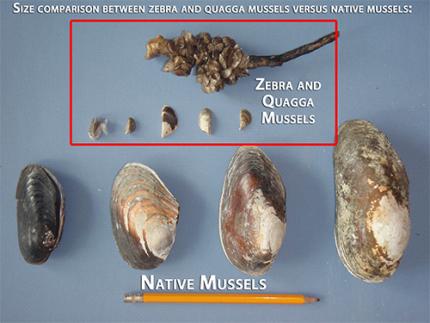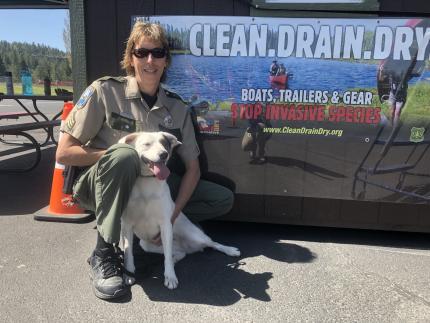June 2024: Invasive freshwater mussel monitoring ramping up in Washington waters
Quagga and zebra mussels can clog pipes and mechanical systems of industrial plants, utilities, locks, and dams. If invasive mussels take hold in Washington, officials estimate it would cost more than $100 million each year to keep Washington’s power and water infrastructure running, in addition to causing catastrophic ecological damage.
Identification
Zebra mussels are relatively small (typically the size of an adult fingernail) with thin shells of variable coloring, often with stripes or zig-zag patterns. They are triangular in shape, and sit flat on ventral side. Quagga mussels are usually light tan to almost white, with narrow stripes, fan shaped, and rounded, and typically larger than the zebra mussel.

Zebra mussels
Size
Adults range from 1/8 to 2 inches in length.
Color
Mostly white or cream-colored with jagged brown or black stripes across the shell.
Shape
Shell is D-shaped. Byssal threads (or ropes) are on the hinge edge of its shell. These threads are unique to zebra and quagga mussels and are not found on native mussels.
Quagga mussels
Size
Adults are slightly larger than the zebra mussels. They can be up to .8 inch wide and more than 2 inches in length.
Color
Shell is normally striped, as is that of the zebra mussel.
Shape
Shell is more rounded (fan shaped with pointed edges at either side) on the hinge edge than zebra mussel shells. Byssal threads (or ropes) are on the hinge edge of its shell. The shells of the quagga mussels are thinner and lighter when they live on soft surfaces, and thicker and heavier when they live on hard or rocky surfaces.
For information on invasive mussels detected in aquarium moss balls in March 2021, please see this webpage.
Limiting invasion
Watercraft inspections

The Washington Department of Fish and Wildlife (WDFW) provides free watercraft inspections in Liberty Lake near Spokane as well as Clarkston, Pasco, and Cle Elum. If needed, staff will provide a free decontamination after inspection. Request a boat inspection.
In 2019, WDFW inspected more than 32,000 watercrafts, a 31% increase from 2018. About one third of inspected watercrafts came from known infested waters in other states. WDFW detected 18 vessels carrying invasive mussels and 1,200 vessels that failed to meet the clean – drain – dry requirements.
Early detection monitoring
Early detection monitoring helps identify invasions early and prevent invasive species from establishing populations. Each year, WDFW takes early detection monitoring samples at dozens of water bodies across the state.
Emergency planning
The state also ramped up its efforts to prepare for a possible invasive mussel infestation with a first-of-its-kind mock exercise alongside state, federal, and tribal governments. The exercise, which took place in Kettle Falls, WA in October 2019, included deploying and testing a containment system, boat inspections, public notifications, a decontamination station, shoreline surveys by trained mussel-sniffing dogs, and in-water monitoring by skilled divers and scientists.
How to help
Boaters, kayakers, anglers and anyone who recreates or works in Washington's waters should take measures to prevent the spread of aquatic invasive species. There are two methods recommended: the basic "Clean/Drain/Dry," and the more rigorous "decontamination" protocol for known or suspected infested waters.
Boaters and anglers should contact WDFW's Aquatic Invasive Species hotline if they suspect their boats or gear have been used in waters of states infested with zebra or quagga mussels (see map).
Aquatic Invasive Species hotline: 1-888-WDFW-AIS (1-888-933-9247)
Aquatic Invasive Species Prevention Permit
Operators of watercraft not registered in Washington State, seaplanes, and commercial transporters of specified vessel types, must buy an Aquatic Invasive Species Prevention Permit. These permits are valid for one year and may be purchased for $24 online or from any of WDFW’s authorized license dealers.
Resources
Presentations, videos, and webinar recordings
View our Quagga and zebra mussel YouTube playlist for all recordings.
- 2024 State of Washington aquatic invasive species quagga and zebra mussel prevention and readiness summit
- 2019 Lake Roosevelt invasive mussel rapid response exercise
- Quagga and zebra mussels - what are they and where did they come from?
- Invasive freshwater quagga and zebra mussel webinar | February 27, 2024